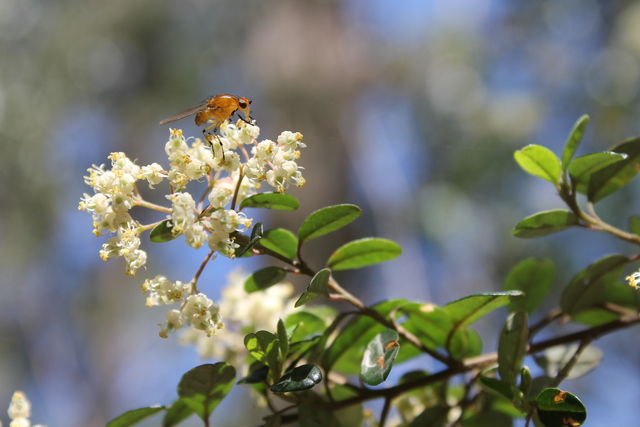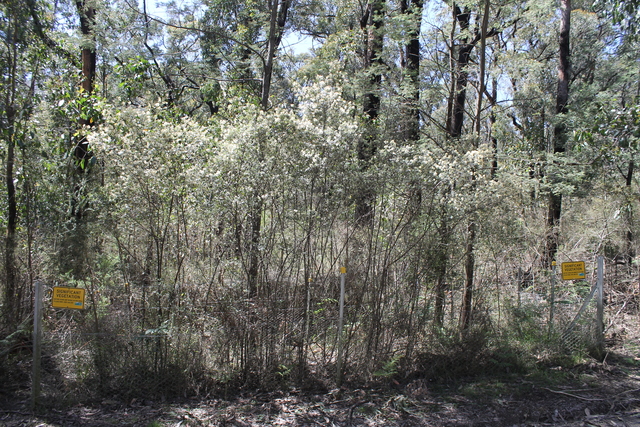A precariously populated plant which calls parts of the Yarra Valley home continues to face threats to its existence, and the Kinglake Friends of the Forest (KFF) are prepared to go to court to protect it.
Pomaderris vacciniifolia, or the round-leaf Pomaderris, is critically endangered, with as few as 150 to 250 mature plants remaining based on the most recent state and federal government assessments, respectively.
Known to be found in the Murrindindi and Yarra Ranges areas, one distinctly eastern population in the Baw Baw Shire is potentially under threat, where Forest Fire Management Victoria (FFMVic) are set to conduct clearing works for a 23-kilometre, 20-metre-wide strategic fuel break (SFB).
KFF president Sue McKinnon said the site has a history of Pomaderris vacciniifolia detections along the roadside and they have found about 30 plants, while the Victorian Biodiversity Atlas also has detections along Cowwarr Road where clearing will be carried out for the SFB.
“For strategic fuel breaks, their standard is that they have at minimum a five metre distance between canopies of trees and it’s quite a dense forest now so that means that most of the trees will be removed, you can actually see which trees will be removed because they’re the ones that don’t have a ribbon around them,” she said.
“They will clear the forest floor, they will remove all the stumps and they will prepare the forest floor for mowing and slashing from then on and we don’t know whether they have surveyed or not for pomaderris or other threatened species in the area,”
“Even if they have and even if they do protect the mature plants that won’t necessitate the survival of those plants into the future because their climate, the light hitting them, the heat hitting them, will be very different to what it was.”
According to VicFlora, there are round-leaf pomaderris populations around Healesville, Badger Creek and Chum Creek in the Yarra Valley, as well as two further east of Warburton.
Ms McKinnon said because this population is on the edge of the plant’s extent of occurrence (the geographic boundary of the plant’s existence), they see the works as a particularly threatening process.
“The extent of this species in the far east will be reduced, they’re the critical and urgent concerns that we have and we’ve found that there are four other strategic fuel breaks they’re going to construct in the pomoderris area, there’s three in the Kinglake area and another one in the Rawson area,” she said
“All the mature species seem to be on road or track side and that’s for various reasons that have not actually been determined, but one of the likely reasons is that they are activated where there’s a small amount of light but a still cool area,”
“They’re also very limited in their regeneration, the seed is only ever found within about five meters of the mature plant… unless there this is a flood or something that carry the seed further on and in most cases, if you have a flood, the seed is carried along the roadside.”
The Victorian Government’s Threatened Species Assessment for the round-leaf pomaderris admits that roadside populations are ‘threatened by road maintenance works and associated fire management and suppression activities including the construction and regular slashing of fire breaks.’
An FFMVic spokesperson said strategic fuel breaks are a critical part of FFMVic’s strategy to protect communities and the environment from bushfire.
“Strategic fuel breaks enable firefighters to get access to the forest to respond to fires and carry out backburning in the event of a major bushfire,” they said.
“By doing work under careful and planned conditions, we avoid having to do it while responding to large, life-threatening fires when we have less time to check for and manage environmental and heritage values.”
The local Warburton Environment group have also taken legal action regarding fire management works in Victoria following the death of an endangered greater glider in the Yarra Ranges National Park.
Dr John Patykowski did his honours research at Deakin University on the conservation ecology of the round-leaf pomaderris and said clearing through a known population for a firebreak is likely to have significant detrimental effect on that local occurrence, potentially resulting in local extirpation (complete extinction in a geographic area).
“P. vacciniifolia likely occupies only a fraction of its former range; much previously suitable habitat is permanently changed, fragmented, or lost through land clearing and development, each extant occurrence thus represents an important insurance population safeguarding the species from extinction,” he said.
“The occurrence of P. vacciniifolia imperilled by the proposed vegetation clearing for a firebreak is significant because it represents the most easterly part of its known range, maintaining the Extent of Occurrence of P. vacciniifolia, as well as Area of Occupancy, are important principles for improving the trajectory of this species,”
“Loss of this occurrence would shrink both the Extent of Occurrence and the Area of Occupancy, reduce genetic representation, and increase extinction risk for this species… at best, the clearing would likely send a functioning population and its seed bank into long-term decline.”
Dr Patykowski is now a research scientist at the North Australian Indigenous Land and Sea Management Alliance Ltd (NAILSMA).









